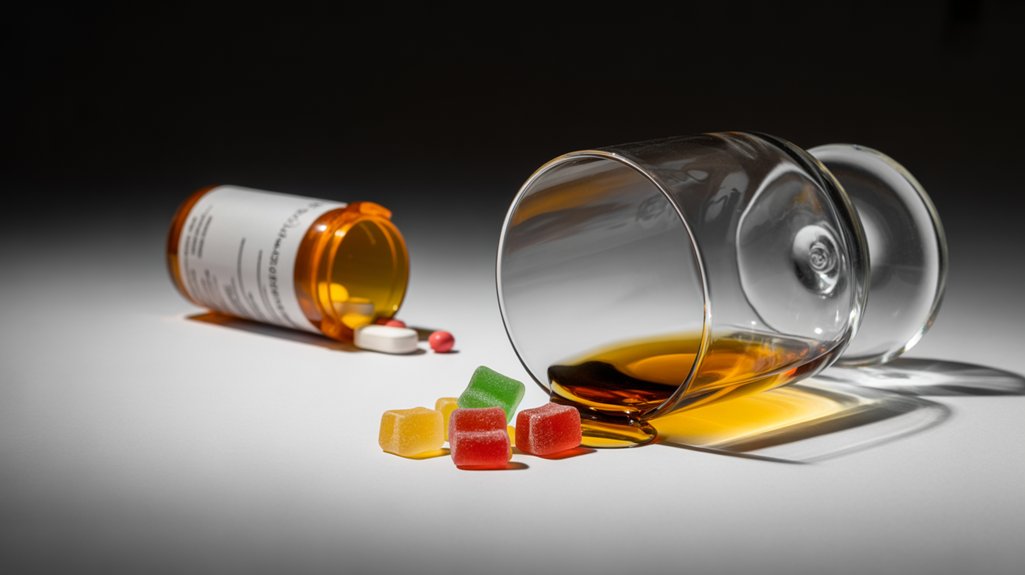When a 25-year-old consumed two delta-9 gummies followed by three beers at a house party, they experienced severe disorientation and couldn’t recognize familiar faces for over six hours. You’re dealing with a complex pharmacological interaction where alcohol greatly accelerates THC absorption, creating unpredictable plasma concentrations that exceed what you’d experience from either substance alone. This combination amplifies cognitive impairment, motor dysfunction, and psychological distress in ways that current research is only beginning to understand.
The Science Behind Delta-9 THC and Alcohol Metabolism

When you consume Delta-9 THC gummies alongside alcohol, you’re introducing two psychoactive substances that undergo distinct yet potentially interfering metabolic pathways in your body.
THC metabolism occurs primarily through hepatic cytochrome P450 enzymes, specifically CYP2C9 and CYP3A4, converting THC into 11-hydroxy-THC and subsequently into THC-COOH.
Alcohol interaction complicates this process because ethanol competes for the same enzymatic systems, particularly affecting first-pass metabolism. This competition can greatly delay THC clearance, prolonging psychoactive effects and increasing plasma concentrations.
Additionally, alcohol enhances THC absorption in your gastrointestinal tract, potentially amplifying intoxication levels. The combined hepatic burden creates unpredictable pharmacokinetic profiles, making it difficult to anticipate onset timing, peak effects, or duration of impairment when you mix these substances.
How Alcohol Affects THC Absorption in Your Body
Although alcohol’s primary metabolic pathway occurs independently of THC processing, ethanol markedly alters your gastrointestinal absorption dynamics for Delta-9 THC gummies through multiple physiological mechanisms.
Alcohol influence accelerates gastric emptying, potentially increasing THC absorption rates in your small intestine where cannabinoids undergo primary uptake. Additionally, ethanol enhances intestinal permeability by disrupting tight junction proteins, allowing greater THC bioavailability into your bloodstream.
Concurrent alcohol consumption also modifies first-pass hepatic metabolism, potentially reducing THC clearance and prolonging cannabinoid exposure.
This combination creates unpredictable pharmacokinetic profiles, with delayed onset times followed by intensified psychoactive effects. You face increased risks of impaired cognitive function, motor coordination deficits, and respiratory depression when combining these substances, particularly at higher doses.
Timing Matters: When You Consume Each Substance
The sequence in which you consume Delta-9 gummies and alcohol considerably influences your body’s pharmacological response and risk profile. Timing effects between these substances create distinct metabolic pathways that affect absorption rates, peak concentrations, and elimination half-lives. Your consumption patterns directly impact the severity of psychoactive interactions and adverse event probability.
Critical timing considerations include:
- Alcohol first, then gummies: Ethanol accelerates THC absorption through enhanced gastric emptying and increased intestinal permeability.
- Simultaneous consumption: Creates unpredictable peak plasma concentrations with heightened risk of respiratory depression and cognitive impairment.
- Gummies first, then alcohol: May intensify sedative effects as THC reaches therapeutic levels while alcohol undergoes first-pass metabolism.
Strategic spacing between substances reduces pharmacokinetic interference and minimizes synergistic toxicity risks.
Physical and Mental Effects of the Combination
Combined consumption of Delta-9 gummies and alcohol produces amplified physiological and psychological effects that exceed what you’d experience from either substance alone.
You’ll encounter severe impairment in mental clarity, making complex cognitive tasks nearly impossible. Your body coordination deteriorates considerably, increasing fall risk and motor vehicle accident probability.
The combination intensifies sedation, potentially leading to dangerous respiratory depression. You may experience heightened anxiety, paranoia, or panic attacks as both substances interact with your central nervous system.
Cardiovascular strain increases through elevated heart rate and blood pressure fluctuations. Memory formation becomes severely compromised, creating gaps in recollection.
These compounded effects persist longer than either substance individually, extending your impairment duration and recovery time considerably.
Safety Risks and Potential Dangers

When you mix Delta-9 gummies with alcohol, you’re exposing yourself to potentially life-threatening complications that demand immediate medical attention. This combination violates established health guidelines and creates a compounding depressant effect on your central nervous system.
Critical safety hazards include:
- Respiratory depression – Your breathing rate can slow to dangerously low levels, potentially causing hypoxia.
- Cardiovascular complications – Blood pressure fluctuations and irregular heart rhythms threaten organ perfusion.
- Cognitive impairment cascades – Severe disorientation, memory blackouts, and compromised decision-making capacity.
Proper risk assessment reveals that unpredictable pharmacokinetic interactions make dosage control impossible. You can’t predict onset timing, peak effects, or duration when these substances interact.
Emergency medical intervention becomes necessary when respiratory rates drop below twelve breaths per minute or consciousness becomes notably altered.
Legal Implications and Driving Concerns
Beyond immediate health risks, combining Delta-9 gummies with alcohol creates severe legal liabilities that can result in felony charges and permanent criminal records.
You’ll face compounded impairment that greatly exceeds legal intoxication thresholds, making DUI convictions virtually inevitable during traffic stops. Legal considerations become complex when both substances are present, as prosecutors can pursue enhanced charges for poly-drug impairment. Driving laws don’t differentiate between individual versus combined substance use—you’re liable for any measurable impairment regardless of source.
Blood tests will detect both THC metabolites and alcohol, providing prosecutors with irrefutable evidence of concurrent use. You’ll encounter license suspension, mandatory rehabilitation programs, substantial fines, and potential incarceration.
Professional licenses, employment opportunities, and insurance rates suffer permanent damage from these convictions.
Harm Reduction Strategies for Safer Use
While complete avoidance represents the safest approach, evidence-based harm reduction protocols can considerably minimize risks if you choose to use these substances.
Combining substances exponentially increases adverse event probability, requiring strict adherence to safety parameters.
Critical harm reduction strategies include:
- Start low, go slow: Begin with minimal doses of each substance, allowing 2-4 hours between consumption to assess individual tolerance and cross-reactive effects.
- Designate substance-free monitoring: Guarantee a sober individual remains present to recognize signs of respiratory depression, cognitive impairment, or medical emergencies.
- Establish consumption limits: Pre-determine maximum quantities before use, removing access to additional substances to prevent impaired decision-making.
You’ll experience delayed onset with delta-9 gummies, making sequential dosing particularly dangerous.
Monitor essential signs, maintain hydration, and immediately seek medical attention if experiencing breathing difficulties or loss of consciousness.
Conclusion
You’re walking a tightrope when you combine Delta-9 THC gummies with alcohol. The pharmacokinetic interactions greatly amplify psychoactive effects through accelerated absorption and altered hepatic metabolism. You’ll experience heightened cognitive impairment, compromised motor function, and increased risk of adverse psychological reactions including anxiety and paranoia. This combination creates dangerous synergistic effects that can’t be predicted or controlled. You’re risking severe intoxication, accidents, legal consequences, and potential acute medical emergencies requiring immediate intervention.






